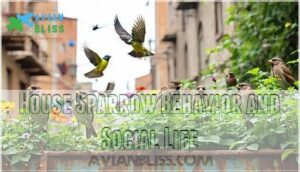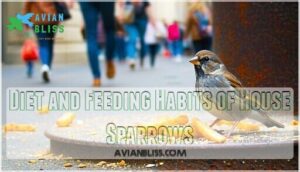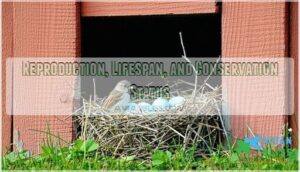This site is supported by our readers. We may earn a commission, at no cost to you, if you purchase through links.
 You’ve watched them hop across sidewalks, squabble over crumbs at outdoor cafes, and nest in the eaves of your home. House sparrows blanket cities and towns worldwide, yet most people walk past them without a second glance.
You’ve watched them hop across sidewalks, squabble over crumbs at outdoor cafes, and nest in the eaves of your home. House sparrows blanket cities and towns worldwide, yet most people walk past them without a second glance.
These small brown birds with stubby beaks arrived from Europe in the 1850s and spread across North America within decades. Their success stems from an uncanny ability to thrive wherever humans build structures and scatter food.
Males flash gray caps and black bibs during breeding season, while females wear streaky brown disguises year-round. Understanding their identification, habits, and surprising population shifts reveals why these common birds deserve closer attention.
Table Of Contents
- Key Takeaways
- House Sparrow Identification and Appearance
- Habitat and Global Distribution
- House Sparrow Behavior and Social Life
- Diet and Feeding Habits of House Sparrows
- Reproduction, Lifespan, and Conservation Status
- Frequently Asked Questions (FAQs)
- Are house sparrows good to have around?
- Why are house sparrows invasive?
- Is the house sparrow a pest?
- What is the difference between a house finch and a house sparrow?
- When do house sparrows begin nesting activities?
- How can house sparrows be deterred from nest boxes?
- What are the primary predators of house sparrows?
- Do house sparrows migrate seasonally?
- How many broods do house sparrows raise annually?
- How do house sparrows communicate vocally?
- Conclusion
Key Takeaways
- House sparrows aren’t native North American sparrows but belong to a different family entirely, arriving from Europe in the 1850s and spreading rapidly by exploiting human-modified landscapes with their stout beaks and adaptable nesting habits.
- These invasive birds aggressively displace native species like bluebirds and tree swallows by killing adults, eggs, or chicks to claim prime nesting cavities, creating serious conservation concerns despite their own surprising 60-84% population decline across multiple continents.
- Males display gray caps and black bibs during breeding season while females wear streaky brown plumage year-round, and both sexes thrive in flocks with clear social hierarchies centered around communal feeding and roosting sites.
- Their success stems from extreme adaptability to human environments—they nest in any sheltered spot from dryer vents to street lights, shift their diet seasonally between seeds and insects, and can raise two to four broods annually wherever people provide food and structures.
House Sparrow Identification and Appearance
If you’ve ever spotted a chunky little bird hopping around a parking lot or perched on a feeder, you might’ve met a house sparrow—but don’t let the name fool you. They’re not your typical North American sparrow, and learning to pick them out from the crowd takes a closer look at their build, colors, and a few telltale marks.
Here’s what to watch for when you’re trying to ID one.
Distinguishing Features From Native Sparrows
You won’t find house sparrows hanging out with their supposed "cousins"—these chunky, round-headed birds belong to an entirely different family than the native sparrows flitting through North American grasslands.
Their body structure sets them apart immediately:
- Stouter beak shape built for cracking seeds
- Fuller chest and shorter tail length than Song Sparrow
- Larger, rounder head size with dusty plumage color
These size and shape differences make identifying this invasive bird species easier once you know what to look for.
Male Vs. Female House Sparrow Comparison
Male and female house sparrows look so different that first-time birders often mistake them for separate species altogether. Males sport a gray and rusty crown with pale cheeks and a bold black bib—perfect plumage differences for attracting mates during mating rituals.
Females are plain from the front, with strong back stripes and no bib at all. Both share that distinctive stout beak shape for cracking seeds.
Juvenile and Nonbreeding Plumage
Young house sparrows resemble females but with softer, fluffier feathers and even less contrast in their markings. You’ll notice their beaks start pale yellow before darkening during plumage development.
Here’s what to watch for during the fledgling stage:
- Beak coloration shifts from yellowish to darker tones as they mature
- Juvenile markings are muted with minimal streaking
- Feather molting occurs gradually as they shift to adult color patterns
- Bird identification gets easier once males develop their signature black bibs
This bird species characteristics guide helps distinguish house sparrow characteristics across age groups.
Size, Shape, and Coloration
House sparrows measure about 14 cm (5.5 inches) from head to tail, making them noticeably chunkier and fuller-chested than most native North American sparrows. Their body proportions include a larger rounded head, stout beak structure, and short notched tail.
The overall color pattern is dusty buffy-brown with minimal contrast. Feather patterns lack bold markings, while plumage texture appears relatively smooth.
These house sparrow characteristics create a distinctive bird physical description that sets them apart from native species.
Habitat and Global Distribution
House sparrows have spread across nearly every continent, thriving wherever humans have settled. You’ll find them in cities, suburbs, farms, and rural towns—basically anywhere people live and work.
Let’s look at the specific environments where these adaptable birds make their home.
Urban and Suburban Environments
You’ll find house sparrows thriving wherever people gather—city sidewalks, shopping centers, apartment complexes, and backyard patios have all become prime real estate for these adaptable birds.
Urban areas provide everything they need: buildings with nooks for nesting, discarded food scraps, and landscaping that mimics their native habitat.
This environmental adaptation showcases how suburban wildlife can exploit city ecosystems shaped by human impact, making house sparrows one of the most successful urban bird species you’ll encounter.
Rural and Agricultural Areas
Step into farm country or rolling croplands, and those same sparrows are right there with you—dusting themselves in barn dirt, raiding grain stores, and nesting in every weathered outbuilding they can find. Agricultural areas offer ideal farm habitat with abundant resources:
- Spilled grain near silos and feed troughs
- Livestock facilities providing shelter and food scraps
- Hedgerows and fence lines for perching and nesting
- Crop fields yielding seeds during harvest season
Rural nesting sites proliferate wherever land use patterns favor agriculture, though crop damage and agricultural impact can frustrate farmers dealing with persistent flocks.
Adaptability to Human Landscapes
What’s striking about these birds isn’t where they live—it’s how fast they’ve conquered new ground. Human impact on landscape ecology has gifted house sparrows with environmental resilience few species match.
Urban planning creates adaptive behavior hotspots: sparrows favor old neighborhoods over fresh construction, and nest site probability jumps when impervious surface exceeds 30% with minimal shrub cover.
Suburban patches link populations across fragmented urban bird habitats, complicating invasive species management and wildlife habitat preservation despite ongoing bird conservation efforts. The decline of house sparrow populations is a concern regarding population decline trends.
House Sparrow Behavior and Social Life
House sparrows don’t fly solo. These birds stick together in flocks and defend their turf with surprising intensity.
You’ll also notice how they interact with native species—and it’s not always friendly.
Flocking and Social Structure
If you’ve ever seen a crowd of small brown birds squabbling over crumbs at a sidewalk café, you’ve witnessed the house sparrow’s talent for sticking together. These birds live in flocks year-round, with flock dynamics driven by a clear social hierarchy. Group behavior centers on communal roosting and feeding sites. Communication patterns include chirps that signal food or danger. Colony formation happens around reliable food sources, creating tight-knit communities.
Here’s what their social structure looks like:
- Dominant males control the best feeding spots and defend them aggressively from younger birds
- Flocks range from a dozen to hundreds depending on food availability and habitat quality
- Birds recognize individual flock members through distinct vocalizations and visual cues
- Social bonds strengthen survival by coordinating predator alerts and resource location
- Roosting sites become communal hubs where birds gather nightly for warmth and protection
Territoriality and Nesting Habits
When house sparrows shift from flock mode to family mode, they turn fiercely territorial and won’t hesitate to pick a fight over a good nesting spot. Males establish breeding territory by singing from perches and chasing rivals away. Aggressive behavior escalates near nesting sites, where they’ll attack intruders with sharp pecks and wing strikes.
| Nesting Site | Nest Architecture | Territorial Marking |
|---|---|---|
| Building cavities | Domed grass structure | Repeated singing perches |
| Nest boxes | Lined with feathers | Wing-fluttering displays |
| Tree holes | Loosely woven stems | Aerial chasing patterns |
| Street lights | Mixed with trash bits | Scent marking substrate |
| Dryer vents | Multiple entrance holes | Vocal alarm calls |
House sparrows are known for weaving messy nests from whatever materials are handy, such as grass, paper strips, and string. Their nesting habits involve cramming material into tight spaces until a sturdy cup is formed. House sparrow habitat preferences lean heavily toward human-made structures, where they’ll defend their breeding territory aggressively throughout the nesting season.
Interaction With Native Birds
You’ll quickly notice house sparrows don’t play nice with native birds. They aggressively outcompete species like bluebirds and tree swallows for nesting cavities, often killing adults, eggs, or chicks to claim prime sites. This aggressive nesting behavior creates serious ecological impact on avian community dynamics.
Their competitive foraging puts pressure on native bird populations at feeders and natural food sources. Avian conservation efforts increasingly focus on managing this invasive species to protect vulnerable native bird species from displacement. Understanding the invasive species impact is essential for developing effective conservation strategies.
Diet and Feeding Habits of House Sparrows
House sparrows aren’t picky eaters—they’ll gobble up just about anything they can find. Their diet shifts with the seasons and what’s available, making them resourceful survivors in cities and farmland alike.
Here’s what fuels these feisty little birds throughout the year.
Preferred Seeds, Grains, and Insects
You’ll find house sparrows munching on a surprisingly varied menu that shifts with the seasons and whatever’s within reach. Seeds top their list—think millet, cracked corn, and weed seeds scattered across lawns and gardens.
During summer, they pivot to insects like caterpillars and beetles, which pack the protein their growing chicks need. At your bird feeder, they’ll happily grab sunflower seeds and grain types you’ve set out.
Foraging and Opportunistic Feeding Strategies
Most foraging happens on the ground, where you’ll spot these birds hopping around parking lots and sidewalks hunting seeds. Urban foraging forces sparrows to travel three times farther than rural birds—around 65 meters per trip—to find quality food.
They’re masters of adaptive feeding and food scavenging, grabbing pastries from bins or checking poultry farms for spilled grain. Their insect hunting focuses on shrubby patches with dense invertebrate prey, while seed preference shifts based on what’s scattered nearby.
Feeding at Bird Feeders
At bird feeders, house sparrows don’t wait their turn—they crowd in, push aside smaller birds, and clean out seed trays before anyone else gets a chance. Their feeder preferences lean toward platform feeders where they can dominate the space.
You’ll see their feeding behavior focused on millet, cracked corn, and sunflower seeds—cheap seed types that match their diet perfectly. These feeding strategies keep native birds hungry while sparrows thrive.
Reproduction, Lifespan, and Conservation Status
House sparrows follow a predictable breeding cycle that starts each spring and can produce multiple broods before summer ends. Understanding their reproduction helps explain why they’ve become so widespread, but it also reveals some surprising vulnerabilities.
Let’s look at how these birds mate, raise their young, and fare in today’s changing world.
Mating and Breeding Cycle
Spring kicks off the house sparrow’s breeding season, when males puff up their black bibs and chirp persistently to win over a mate. These courtship behaviors include wing-fluttering displays and hopping around the female.
Once paired, house sparrows form monogamous bonds that last through the breeding season. The female usually lays up to eight eggs per clutch, with both parents sharing incubation duties for 10-14 days.
Nesting and Chick Development
After the eggs hatch, both parents work tirelessly to feed their chicks a protein-rich diet of insects and caterpillars. The chicks grow rapidly in their nest, which house sparrows build in cavities, crevices, or even nest boxes—anywhere sheltered will do.
These nesting sites often belong to native species, which sparrows aggressively displace. Young sparrows reach the fledgling stage around two weeks old, leaving the nest to begin flying shortly after.
Predators and Threats
Despite being common, house sparrows face real dangers. Hawks, falcons, and owls hunt adult sparrows, while domestic cats, raccoons, and snakes target eggs and juveniles through nest predation. Human persecution sometimes occurs because they’re invasive species that displace native birds.
Climate change and the environmental impact of invasive species create complex threats affecting wildlife conservation efforts. Though classified as least concern for bird conservation, their vulnerability to predators and habitat pressures remains constant.
Population Trends and Conservation Concerns
Alarmingly, the house sparrow population decline spans continents despite its invasive species status and widespread distribution. While IUCN lists them as least concern, the conservation status masks troubling population trends:
Despite its invasive status, house sparrows face alarming global population declines—Europe lost 60%, North America 84%—masked by their least concern conservation label
- Europe has lost nearly 60% of sparrows over 21 years, with Britain down 68% and some regions experiencing 90% drops
- North America shows an 84% population decline since 1966, with disappearances from major cities
- India reports 70–80% reductions in urban areas, prompting designation as state bird in Delhi and Bihar
Habitat loss from urban planning, agricultural intensification, pesticide use, and reduced nesting sites drive these ecological impact concerns. Bird conservation efforts now include nest boxes, native vegetation planting, and World Sparrow Day campaigns to address this unexpected vulnerability.
Frequently Asked Questions (FAQs)
Are house sparrows good to have around?
Think of it like inviting a guest who might overstay their welcome. These nonnative birds disrupt Environmental Balance by competing aggressively with native species for nesting sites.
While common in Urban Wildlife settings and popular with Backyard Birding enthusiasts, their presence as an Invasive Species often harms Bird Diversity, challenging Bird Conservation and Wildlife Management efforts.
Why are house sparrows invasive?
The House Sparrow is labeled an invasive species because it displaces native birds from nesting sites, often killing them to claim cavities.
This invasive bird causes environmental harm and requires wildlife management strategies to protect local ecosystems.
Is the house sparrow a pest?
Many consider it a pest due to its aggressive nesting behavior and displacement of native birds.
This invasive species causes environmental harm through native displacement, making it a wildlife management concern requiring pest control strategies for bird conservation.
What is the difference between a house finch and a house sparrow?
You’ll spot the difference mainly through beak shape and plumage color. House finches have slender, conical beaks and reddish-brown feather patterns on males, while house sparrows display stouter bills and black bibs.
Their nesting habits and song differences also set them apart in bird identification.
When do house sparrows begin nesting activities?
Like clockwork ticking toward warmth, nesting season begins in early spring. House sparrows start nest construction and breeding cycles in March through April.
You’ll notice males singing to attract mates, then both parents weaving nests in cavities or building crevices for egg laying and fledgling care.
How can house sparrows be deterred from nest boxes?
You can modify nest box entrance holes to 25 inches or smaller—this excludes house sparrows while allowing native species access. Removing perches from birdhouse designs also helps, as does temporarily blocking nesting sites when invasive birds show interest.
What are the primary predators of house sparrows?
House sparrows face numerous threats, including hawk attacks, falcon predation, and owl threats from above. Additionally, snake invasions and raccoon menaces target their eggs and juveniles, making them vulnerable in dangerous environments.
In the fields of wildlife biology and ornithology, understanding avian species predator-prey relationships is crucial. This knowledge sheds light on how bird behavior and habitat choices influence their survival patterns.
Do house sparrows migrate seasonally?
Migration patterns remain stable throughout the year for this species. Unlike many bird migration patterns, house sparrows don’t show seasonal movements or habitat shifts driven by climate effects.
Bird tracking studies confirm house sparrow behavior centers on permanent territories near nesting sites year-round.
How many broods do house sparrows raise annually?
You’ll see two or three broods from house sparrows in a typical year, though some pairs push for four during favorable breeding seasons.
Their nesting success depends on food availability and habitat quality, making annual cycles flexible rather than fixed.
How do house sparrows communicate vocally?
Bird vocalizations include diverse call types and song patterns used for specific purposes. Males use repetitive chirping to attract mates, while both sexes rely on vocal learning to perfect their call pattern throughout life.
You’ll hear house sparrows produce territorial calls, courtship songs, and alarm notes.
Conclusion
The most overlooked bird might be the most revealing one. House sparrows mirror our own footprint—thriving in cities we built, struggling when we abandon them, adapting faster than native species can compete.
You’ve seen these birds your entire life, yet their presence tells a story about displacement, resilience, and what happens when ecosystems collide.
Next time one lands at your feet, consider this: the house sparrow doesn’t just live alongside us—it’s become a living measure of how deeply we’ve reshaped the world.











